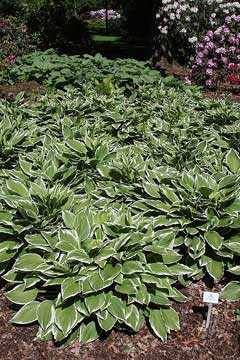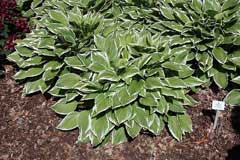 |
|
http://commons.wikimedia.org/wiki/User:Syker_Fotograf |
 |
| http://commons.wikimedia.org/wiki/User:Syker_Fotograf |
Translate this page:
Summary
Physical Characteristics

 Hosta crispula is a PERENNIAL growing to 0.6 m (2ft) by 1 m (3ft 3in) at a slow rate.
Hosta crispula is a PERENNIAL growing to 0.6 m (2ft) by 1 m (3ft 3in) at a slow rate.
See above for USDA hardiness. It is hardy to UK zone 4 and is not frost tender. It is in flower from June to July. The species is hermaphrodite (has both male and female organs).
Suitable for: light (sandy), medium (loamy) and heavy (clay) soils and can grow in heavy clay soil. Suitable pH: mildly acid, neutral and basic (mildly alkaline) soils. It can grow in semi-shade (light woodland) or no shade. It prefers moist soil.
UK Hardiness Map
US Hardiness Map
Synonyms
Plant Habitats
Woodland Garden Sunny Edge; Dappled Shade; Shady Edge; Ground Cover;
Edible Uses
Edible Parts: Stem
Edible Uses:
Leaf stems - raw or cooked[K]. Crisp and sweet but rather fibrous and chewy[K].
References More on Edible Uses
Medicinal Uses
Plants For A Future can not take any responsibility for any adverse effects from the use of plants. Always seek advice from a professional before using a plant medicinally.
None known
References More on Medicinal Uses
The Bookshop: Edible Plant Books
Our Latest books on Perennial Plants For Food Forests and Permaculture Gardens in paperback or digital formats.

Edible Tropical Plants
Food Forest Plants for Hotter Conditions: 250+ Plants For Tropical Food Forests & Permaculture Gardens.
More

Edible Temperate Plants
Plants for Your Food Forest: 500 Plants for Temperate Food Forests & Permaculture Gardens.
More

More Books
PFAF have eight books available in paperback and digital formats. Browse the shop for more information.
Shop Now
Other Uses
A good ground cover plant[197]. Plants should be spaced about 45cm apart each way[208].
Special Uses
Food Forest Ground cover
References More on Other Uses
Cultivation details
Thrives in most fertile soils if they are rich in humus[200]. Grows well in heavy clay soils and in sandy ones[208]. Very limy soils inhibit growth, but plants can thrive in such a situation if plenty of humus is added[208]. Prefers a pH between 6 and 7[200]. Requires a rich soil that does not dry out readily[1]. Succeeds in full sun as well as in deep shade, growing well in the semi-shade of a woodland[200, 233]. In general, the sunnier the position the moister the soil should be[233]. Another report says that the plant should be grown in full shade[251]. Plants are best not grown under trees in town gardens since the soot washed from the leaves of the trees in wet weather will tend to remain on the hosta[208]. Plants flower better when grown in a sunny position but the foliage is better when the plant is in a shady position[200]. Requires some protection from the wind[188, 251]. A very slow-growing plant[251], it is in general fully hardy in Britain, but the young leaves in spring can be destroyed by frost. New leaves are only produced in the spring and very early summer, so any damage at this time has a deep effect on the plant[233]. Members of this genus are rarely if ever troubled by browsing deer or rabbits[233]. Plants are very attractive to slugs and snails, the young shoots in spring are especially at risk[111, K]. This plant is not recognised as a species by some authorities, who see it as a garden hybrid H. 'Crispula'[251]. Especially when grown in less than ideal conditions, this species is easily confused with H. 'Thomas Hogg' and H. fortunei 'Albomarginata'[200]. Hybridizes freely with other members of this genus[200]. There are some named forms selected for their ornamental value[200]. This species is prone to virus disease[188, 251].
References Carbon Farming Information and Carbon Sequestration Information
Temperature Converter
Type a value in the Celsius field to convert the value to Fahrenheit:
Fahrenheit:
The PFAF Bookshop
Plants For A Future have a number of books available in paperback and digital form. Book titles include Edible Plants, Edible Perennials, Edible Trees,Edible Shrubs, Woodland Gardening, and Temperate Food Forest Plants. Our new book is Food Forest Plants For Hotter Conditions (Tropical and Sub-Tropical).
Shop Now
Plant Propagation
Seed - sow spring in a lightly shaded position in a greenhouse and only just cover the seed. Germination usually takes place within 1 - 3 months at 10°c. Make sure you keep the compost moist. When they are large enough to handle, prick the seedlings out into individual pots and grow them on in the greenhouse for at least their first winter. Plant them out into their permanent positions in late spring or early summer, after the last expected frosts. Division is possible at almost any time of the year so long as there is sufficient moisture[233]. It is best carried out in March as growth commences or in early autumn if the soil is not too dry[200]. Hostas can be left undivided for many years and should not be divided any more frequently than once every 3 - 5 years to allow the leaves to reach maturity[200].
Other Names
If available other names are mentioned here
Native Range
Coming Soon
Weed Potential
Right plant wrong place. We are currently updating this section.
Please note that a plant may be invasive in one area but may not in your area so it's worth checking.
Conservation Status
IUCN Red List of Threatened Plants Status :

Growth: S = slow M = medium F = fast. Soil: L = light (sandy) M = medium H = heavy (clay). pH: A = acid N = neutral B = basic (alkaline). Shade: F = full shade S = semi-shade N = no shade. Moisture: D = dry M = Moist We = wet Wa = water.
Now available:
Food Forest Plants for Mediterranean Conditions
350+ Perennial Plants For Mediterranean and Drier Food Forests and Permaculture Gardens.
[Paperback and eBook]
This is the third in Plants For A Future's series of plant guides for food forests tailored to
specific climate zones. Following volumes on temperate and tropical ecosystems, this book focuses
on species suited to Mediterranean conditions—regions with hot, dry summers and cool, wet winters,
often facing the added challenge of climate change.
Read More
Expert comment
Author
F.Maek.
Botanical References
200
Links / References
For a list of references used on this page please go here
Readers comment
© 2010, Plants For A Future. Plants For A Future is a charitable company limited by guarantee, registered in England and Wales. Charity No. 1057719, Company No. 3204567.